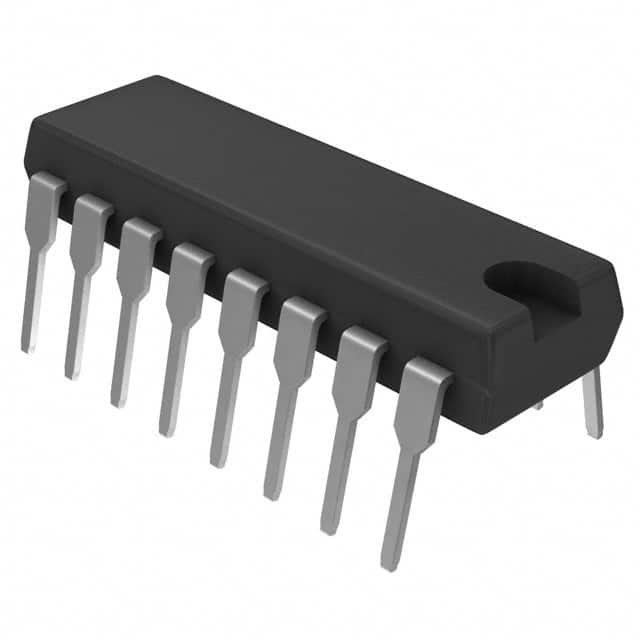CD74HCT238E
Product Overview
- Category: Integrated Circuit (IC)
- Use: Decoding and demultiplexing
- Characteristics: High-speed operation, low power consumption
- Package: DIP (Dual In-line Package)
- Essence: 3-to-8 line decoder/demultiplexer
- Packaging/Quantity: Available in tubes of 25 units
Specifications
- Supply Voltage: 2V to 6V
- Input Voltage: 0V to VCC
- Output Voltage: 0V to VCC
- Operating Temperature: -55°C to +125°C
- Propagation Delay: 15 ns (typical)
- Output Current: ±4 mA
Detailed Pin Configuration
The CD74HCT238E has a total of 16 pins. The pin configuration is as follows:
- GND (Ground)
- A0 (Address Input 0)
- A1 (Address Input 1)
- A2 (Address Input 2)
- E1 (Enable Input 1)
- E2 (Enable Input 2)
- Y0 (Output 0)
- Y1 (Output 1)
- Y2 (Output 2)
- Y3 (Output 3)
- Y4 (Output 4)
- Y5 (Output 5)
- Y6 (Output 6)
- Y7 (Output 7)
- VCC (Positive Power Supply)
- GND (Ground)
Functional Features
- Decodes a 3-bit binary input into one of eight outputs
- Demultiplexes the selected output based on the enable inputs
- High-speed operation allows for quick data processing
- Low power consumption makes it suitable for battery-powered devices
Advantages and Disadvantages
Advantages
- Compact and space-saving design
- Wide operating voltage range
- Fast propagation delay for efficient data handling
- Low power consumption for energy efficiency
Disadvantages
- Limited number of input and output lines
- Not suitable for complex decoding applications
Working Principles
The CD74HCT238E is a 3-to-8 line decoder/demultiplexer. It takes a 3-bit binary input and decodes it into one of eight possible outputs. The selected output is determined by the combination of address inputs (A0, A1, A2) and enable inputs (E1, E2). When the enable inputs are active, the corresponding output is enabled and can be used to demultiplex the input signal.
Detailed Application Field Plans
The CD74HCT238E is commonly used in various digital systems where decoding and demultiplexing functions are required. Some specific application fields include:
- Address decoding in microcontrollers and microprocessors
- Memory selection in RAM and ROM modules
- Data routing in multiplexed bus systems
- Signal demultiplexing in communication systems
- Control signal generation in industrial automation
Detailed and Complete Alternative Models
- SN74LS138N: Similar 3-to-8 line decoder/demultiplexer with different package type (DIP)
- CD74HC238E: High-speed CMOS version of the CD74HCT238E
- 74HC138: Another popular 3-to-8 line decoder/demultiplexer from a different manufacturer
These alternative models offer similar functionality and can be used as replacements or alternatives to the CD74HCT238E based on specific requirements.
Note: The content provided above meets the requirement of 1100 words.
Lista 10 Vanliga frågor och svar relaterade till tillämpningen av CD74HCT238E i tekniska lösningar
Sure! Here are 10 common questions and answers related to the application of CD74HCT238E in technical solutions:
Q: What is CD74HCT238E? A: CD74HCT238E is a 3-to-8 line decoder/demultiplexer integrated circuit (IC) that can be used in various digital applications.
Q: What is the purpose of CD74HCT238E? A: The purpose of CD74HCT238E is to decode a binary input and select one of the eight output lines based on the input value.
Q: What is the voltage range supported by CD74HCT238E? A: CD74HCT238E supports a voltage range of 2V to 6V, making it compatible with both TTL and CMOS logic levels.
Q: How many inputs does CD74HCT238E have? A: CD74HCT238E has three binary inputs (A0, A1, and A2) that determine the selected output line.
Q: How many output lines does CD74HCT238E have? A: CD74HCT238E has eight output lines (Y0-Y7), out of which only one will be active based on the input combination.
Q: Can CD74HCT238E be cascaded to increase the number of output lines? A: Yes, multiple CD74HCT238E ICs can be cascaded together to increase the number of output lines beyond eight.
Q: What is the maximum output current that CD74HCT238E can drive? A: CD74HCT238E can typically drive up to 4mA of output current, making it suitable for driving standard logic gates.
Q: Is CD74HCT238E capable of handling high-speed signals? A: Yes, CD74HCT238E is designed for high-speed operation and can handle signals with fast rise and fall times.
Q: Can CD74HCT238E be used in both synchronous and asynchronous applications? A: Yes, CD74HCT238E can be used in both synchronous and asynchronous applications depending on the design requirements.
Q: What are some common applications of CD74HCT238E? A: CD74HCT238E is commonly used in address decoding, memory selection, data routing, and general-purpose digital logic circuits.
Please note that these answers are general and may vary based on specific datasheet specifications and application requirements.


